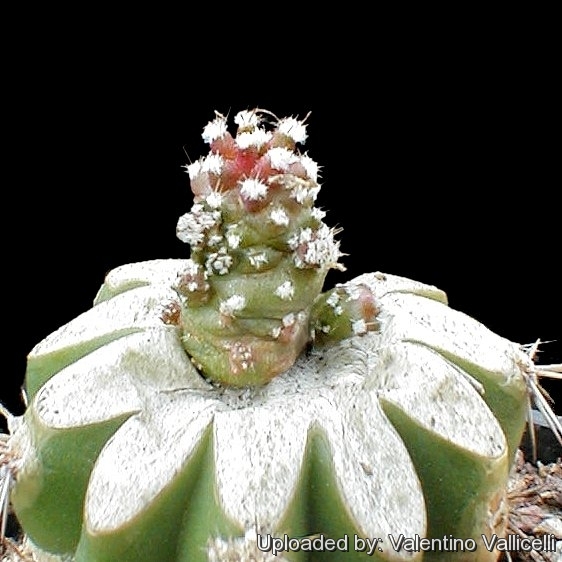
Pediocactus sileri f. monstruosa Photo by: Valentino Vallicelli
Origin and Habitat: Garden origin (Nursery produced cultivar)
Synonyms:
See all synonyms of Pediocactus sileri
Description: Pediocactus sileriSN|18235]]SN|18235]] f. monstruosa (a.k.a. Utahia sileriSN|18237]]SN|18237]] f. monstruosa) is a tiny highly branching cactus with very short bristly spines that forms dense oddlly shaped clumps. This form reproduces vegetatively and it is possible to find clones with different degrees of monstrosity or deformity. It is a very rare cactus and most difficult to grow on its own roots. It is better to graft it on a suitable grafting stock.
Habit: It is a small highly branching cactus that forms crowded clumps.
Stems: Globose or elomgate up to 6 cm tall freely branching and retaining the basic spherical structure with spiralling tubercled ribs.
Areoles: Large, white and felty, they are arranged geometrically and contrast with the stem.
Spines: Very short, thin, bristly, spreading.
Fruit: Not seen.
Remarks: This is a very distinctive plant even without flowers. It’s very different from the common spiny form. Maybe we can call it a freak?
Subspecies, varieties, forms and cultivars of plants belonging to the Pediocactus sileri group
Cultivation and Propagation: It is relatively difficult and need appropriate growing conditions in order to obtain compact plant with many stems. This form reproduces vegetatively and it is possible to find clones with different degrees of monstrosity or deformity.
Soil: Use a an open and free draining mineral compost with little organic matter (peat, humus) that allows therefore roots to breath (as it is rot prone). Outdoors a well-draining rocky or sandy soil is ideal.
Pots: It needs a relatively shallow pot to accommodate its fibrous roots and provide a very good drainage. It may stay in the same pot for many years.
Watering: Needs regular water in summer. Keep rather dry in winter, tends to lose its roots in winter.
Fertilization: Feed with a high potassium fertilizer in summer during the growing season diluted to one-fourth potency and mix into the watering can for application.
Hardiness: Keep dry at 5- 10° C in winter, but can tolerate sporadic light frost if kept on the dry side prior to, and during, cold weather.
Exposition: The plant tolerates very bright situations, if kept too dark they may become overly lush and greener and could be prone to rotting due to over watering. Strong light encourages flowering and heavy wool and spine production, but is likely to suffer from sun scorch or stunted growth if over exposed to direct sunlight during the hottest part of the day in summer.
Pests & diseases: It may be attractive to a variety of insects, but plants in good condition should be nearly pest-free, particularly if they are grown in a mineral potting-mix, with good exposure and ventilation. Nonetheless, watch carefully for any significant decline in health. This may signal a pest problem that should be dealt with quickly in order to prevent scarring, stunting and even death.
- Red spiders: Red spiders may be effectively rubbed up by watering or misting the plants from above.
- Mealy bugs: Mealy bugs occasionally develop aerial into the new growth among the leaves with disfiguring results, but the worst types develop underground on the roots and are invisible except by their effects. Eliminate mealybug infestations by dabbing the critters with cotton swabs dipped in alcohol or by soaking the succulent's roots in a systemic insecticide.
- Scales: Scales are rarely a problem.
- Rot: This species is particularly easy and accommodating, seldom suffer of cryptogamic diseases. Rot it is only a minor problem with cacti if the plants are watered and “aired” correctly. If they are not, fungicides won't help all that much.
Propagation: Exclusively by grafting.










